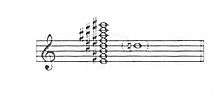Homunculus C.F.
Julia Perry's Homunculus C.F., scored for harp, celesta/piano, and eight additional percussionists, was composed during the summer of 1960 in Akron, Ohio, and completed in 1961.[1] It was during this time that Perry was living in an apartment above her father's medical office. In Perry's record liner notes, she stated, "Having selected percussion instruments for my formulae, then maneuvering and distilling them by means of the 'Chord of the Fifteenth' (C.F.), this musical test tube baby was brought to life."[2]
Instrumentation
The piece is scored for four timpani, a small and large suspended cymbal, two medium cymbals, snare drum, bass drum, small and large wood blocks, xylophone, celesta/piano, vibraphone, and harp.[3]
Significance
This particular piece was a watershed work for Perry as she focused her attention toward more experimental music. Perry described the piece as, "pantonal".[4]
History
According to Perry's notes on the piece, the "clinical surroundings" of her living quarters above her father's medical office, reminded her of the scene in part 2 of Goethe's Faust in which Wagner, Faust's apprentice, brings life to Homunculus (Latin for "little man") thru alchemy. As in the process of alchemy, Perry's style of composition displays an "unfolding" of material.[5]
Structure
The piece is composed in four sections around Perry's theme of the "Chord of the Fifteenth", which alternates the use of major and minor thirds beginning on E above Middle C.[5] The A section (mm. 1–40) is rhythmic in nature, using only unpitched percussion, then leading to a transition (mm. 41–60) that adds three pitches (D-sharp, G-sharp, and F-sharp) through the timpani; the B section is melodic in nature, using duets between the timpani, harp, and celesta/piano (mm. 61–94). Harmony is the theme for the C section (mm. 95–105), featuring an increasingly dense texture while presenting the first four pitches in the chord only; and the fourth and final section combines each element of harmony, melody, and rhythm in a recapitulation, while introducing the remaining pitches of the chord upon which the work is based (A-sharp, C-sharp, and E-sharp).[6] The final phrase (mm. 171–180) builds to the climax that includes all ten performers and all eight pitches in m. 177,[7] signifying the "creation" of Homunculus.[6]

Perry's "Chord of the Fifteenth" is a structural chord built on E and consists of a major third, a perfect fifth, a major seventh (with a minor seventh appearing frequently in one section), a major ninth, an augmented eleventh, a major thirteenth, and an augmented fifteenth.[7]
Recordings and performances
Homunculus C.F. was recorded by the Manhattan Percussion Ensemble (1960), conducted by Paul Price. Norman Bergen performed the celesta part on the original recording with the Manhattan Percussion Ensemble, dated January 28, 1965 at Steinway Hall. Bergen stated in a 2014 interview that Perry did attend the recording session. He remembered her as, "a tall, thin woman with short hair; very nice! She made me feel comfortable and knew how to speak to young musicians so we would not be intimidated."
Additional works
Perry's other notable works include Stabat Mater for contralto and string orchestra or string quartet,[7] her 1959 Requiem for Orchestra, or Homage to Vivaldi, based on themes by the composer; several shorter orchestral works; chamber music; a violin concerto; twelve symphonies; and two piano concertos. In addition to instrumental works, she composed a three-act opera titled,The Symplegades, based on the seventeenth century Salem Witch Trials, an opera-ballet based on Oscar Wilde's fable, The Selfish Giant, Five Quixotic Songs (1976) for bass-baritone solo, two clarinets, baritone horn, and piano; and Bicentennial Reflections (1977) for tenor solo and six instruments.[4]
External links
Homunculus C.F. was recorded by the Manhattan Percussion Ensemble on January 28, 1965 at Steinway Hall , conducted by Paul Price. https://www.youtube.com/watch?v=
References
Notes
Sources
- Ammer, Christine. Unsung: A History of Women in American Music. Amadeus Press. Hong Kong: 2001. ISBN 1574670611
- Briscoe, James. R. Historical Anthology of Music by Women. Indiana University Press. Bloomington:1987.
- Denby Green, Mildred. Julia Amanda Perry. Historical Anthology of Music by Women. ed. James Briscoe. Indiana University Press. Bloomington: 1987.
- Floyd, Jr., Samuel. International Dictionary of Black Composers, vol. 2. Fitzroy Dearborn Publishers. 1999. OCLC 832432129
- Hayes, Eileen M. and Linda F. Williams. Black Women and Music: More Than the Blues. University of Illinois: 2007. ISBN 978-0-252-07426-4
- Pendle, Karin. Women & Music: A History. 2nd edition. Indiana University Press. Bloomington: 2001. ISBN 978-0253214225
- Perry, Julia. Homunculus C.F. for percussion and harp. Southern Music Publishing Co. 1966.
- Walker-Hill, Helen. From Spirituals to Symphonies: African-American Women Composers and Their Music. Greenwood Press. Westport, Connecticut: 2002. ISBN 978-0-313-29947-6